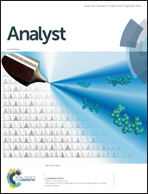Rapid and specific detection of cell-derived microvesicles using a magnetoresistive biochip†
Abstract
Microvesicles (MVs) are a promising source of diagnostic biomarkers which have gained a wide interest in the biomedical and biosensing field. They can be interpreted as a “fingerprint” of various diseases. Nonetheless, MVs implementation into clinical settings has been hampered by the lack of technologies to accurately characterize, detect and quantify them. Here, we report the specific sensing and quantification of MVs from endothelial cells using a portable magnetoresistive (MR) biochip platform, in less than one hour and within physiologically relevant concentrations (1 × 108 MVs per ml). MVs were isolated from both endothelial and epithelial cells undergoing apoptosis, and characterized by atomic force microscopy (AFM) and nanoparticle tracking analysis (NTA), which revealed similar MV sizes. Importantly, our results showed that the two distinct MV populations could be discriminated with the MR biochip platform, with over a 5-fold capture efficiency of endothelial MVs in comparison to the control (epithelial MVs). Also, unspecific binding of MVs to BSA was less than 1% of the specific signal. The detection strategy was based on a sandwich immunoassay, where MVs were labelled with magnetic nanoparticles (MNPs) functionalized with Annexin V and then captured by anti-CD31 antibodies previously immobilized on the surface of the sensor. Results suggest that this approach allows the detection of specific MVs from complex samples such as serum, and highlight the potential of this technology to become a suitable tool for MVs detection as a complementary method of diagnosis.



 Please wait while we load your content...
Please wait while we load your content...